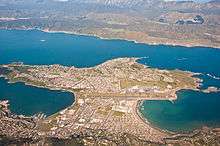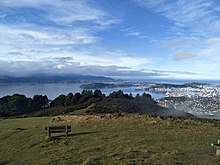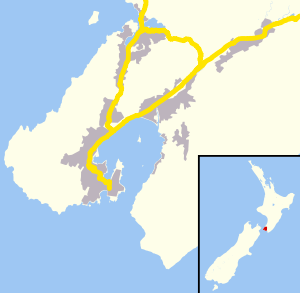Miramar Peninsula
The large Miramar Peninsula (Māori: Te Motu Kairangi) is on the southeastern side of the city of Wellington, New Zealand, at the entrance to Wellington Harbour, in Wellington's eastern suburbs. According to Māori legend, it was formed when the taniwha Whaitaitai beached as he tried to escape the confines of the harbour.[1]



Situation
From above, the peninsula resembles the shape of a shark. Northwards, it juts into Wellington Harbour (formerly known as Port Nicholson, and in Māori as Te Whanganui-a-Tara, the Great Harbour of Tara). To the south are Cook Strait and the South Pacific Ocean. The suburbs of Kilbirnie, Lyall Bay, Hataitai and Newtown, and the inner city, lie to the west. To the east a narrow stretch of water connects Wellington Harbour with Cook Strait and the open sea; beyond this channel are the scrubby Eastbourne hills, and the high and forested Orongorongo Ranges. From the peninsula's high points, an observer can look north to the Hutt Valley and the Tararua Ranges, or southwest, across Cook Strait, to the high peaks of the Inland and Seaward Kaikoura Ranges, which are often snowbound in winter.
Physical description of the peninsula
The peninsula has an area of 800 hectares.[2] The coastline is rocky, with many coves, steep cliffs, and small pinnacles and caves, but there are also sweeping and sandy beaches, notably at Breaker Bay, Worser Bay, Scorching Bay, Moa Point and Tarakena Bay. A high ridge, running on an approximate north/south axis, forms the spine of the peninsula, with high points Mount Crawford in the north and Beacon Hill in the south. The peninsula has a large area of low-lying land, the Miramar flats, and a smaller area of flat land at Seatoun, both of which are mainly covered in residential housing.
The peninsula is largely urbanized, with large suburbs of Miramar, Maupuia, Strathmore and Seatoun, and narrow strips of houses along the coast at Breaker Bay, Karaka Bay and Moa Point. The urban area is a mix of suburban housing, retail outlets, schools, light and service industries, recreation grounds (such as a golf course and sports fields), and Wellington airport. There are also extensive areas of regenerating native bush, pine forest, and remnant farmland, as well as urban gardens. A narrow two-lane road circles the peninsula, providing a picturesque route around the many bays, coves and headlands.
At the entrance to Wellington Harbour, the rocks of Barrett Reef lie close to the shore of the peninsula. On 10 April 1968 TEV Wahine, an inter-island ferry, foundered on Barrett Reef, and later capsized near Steeple Rock, a pinnacle just off Seatoun). 53 people were killed.
Notable landmarks
Notable landmarks include:
- Wellington International Airport
- Its runway runs north-south along the western side, separating Miramar from Rongotai, Lyall Bay and Kilbirnie. A tunnel for pedestrians and cyclists runs on a west/east axis beneath the runway, from Miro Street in Miramar to Coutts Street in Rongotai.
- Massey Memorial
- The marble mausoleum of Prime Minister William Massey (1856 - 1925), on a headland at Point Halswell, at the northern tip of the peninsula. It can be accessed from Massey Road, along a short walking track.
- Atatürk Memorial
- A plinth on a cliff overlooking Tarakena Bay and Cook Strait commemorates Mustafa Kemal Atatürk, founder of the Republic of Turkey, statesman and general, who led Turkish troops in action against New Zealand soldiers at Gallipoli in the First World War.
- Rangitatau and Poito
- Site of a Māori kainga (village) and pa in bush above Tarakena Bay, near the Atatürk Memorial. In pre-European times, people of the Ngai Tara and Ngati Ira iwi lived here, using the site for fishing in Cook Strait. In 1819-20, Nga Puhi and Ngati Toa raiders attacked and sacked the pa, and killed, enslaved or drove off its inhabitants.[3]
- Eastern Walkway
- A walking track that traverses the main ridge from the Pass of Branda to Tarakena Bay. It runs for 2.5 km, passing mainly through regenerating native forest, and provides excellent views of Wellington city, the Miramar Peninsula, Wellington Harbour and Cook Strait.[4]
- The cutting
- Through a low ridge on the peninsula's eastern side, providing a thoroughfare from Cobham Drive to Miramar Avenue and central Miramar. It was constructed in 1910. Above the entrance are large letters forming the word 'Wellington', with the last few letters angling up as if being blown away in the fierce wind. Intended to be seen from the air when landing from the North at Wellington Airport.
- Shelly Bay buildings
- From 1885 to 1995, Shelly Bay was a naval and air force base, and many barracks, workshops, stores, wharves and slipways were built. Concrete munitions magazines are in pine forest above the bay. The area is now owned by local iwi, through the Port Nicholson Trust.
- Fort Ballance
- Fort Ballance was the premier fort in the Wellington area for 26 years (1885-1911). Used by the military over a period of 60 years (1885-1945), the 1880s layout of Fort Ballance is largely unaltered and a good impression of the original nineteenth century fort remains. The fort is a permanent reminder of the technology used in the coastal defence network of the 1880s and it is an early example of the use of concrete as a building material.[5]
Weather
The peninsula is exposed to Wellington's prevailing northwest wind and the southerly wind. During southerly storms, big waves and swells batter the peninsula's rocky southern shore. The peninsula's topography, with its high ridges and small bays and coves, provides shelter from the wind to many places. On 15 August 2011, during a prolonged southerly storm, snow fell across the peninsula in the late morning, settling in light drifts on trees, streets and fields. Like other parts of Wellington, snowfall at sea level is a very rare occurrence.
Historical aspects
There are a number of derelict military fortifications on the peninsula. From the late 19th century to the Second World War, the peninsula was an important component of an evolving coastal defence system, designed to protect the capital, harbour and hinterland from naval attack.
In an era when naval power was based mainly on battleships, Miramar's strategic position made it ideal for coastal guns to prevent enemy warships approaching, bombarding the city, and entering Wellington Harbour. Large coastal artillery fortifications were built at Fort Ballance in 1885, at Fort Dorset from 1908, and Palmer Head from 1936. In the Second World War, the advent of naval air power made these coastal fortifications largely redundant, because an enemy could carry out aerial attacks, using planes launched from aircraft carriers well beyond the range of even the largest shore-based guns.
Some of the fortifications are in reasonable condition, and can be readily accessed on foot. Fort Ballance, overlooking the channel, is a short walk from Scorching Bay or Mahanga Bay. These Victorian fortifications feature concrete gun emplacements, observation posts and underground rooms. At Breaker Bay, a trail runs along the low ridge above between the beach and Seatoun, passing two battery observation posts, a command post, and concrete foundations for artillery guns. At Point Halswell, the concrete emplacements for World War Two anti-aircraft guns and a command post can be reached from the Massey Memorial or a road running down from Mount Crawford. Nearby is a Victorian gun position at Kau Point, overlooking Wellington Harbour. At Palmer Head, a radar station is on the cliffs above Moa Point, looking out across Cook Strait, and is a short walk from Ahuriri Street.
Origin of the name 'Miramar'
"Miramar" means "sea view" in Spanish. The name was chosen by the first European to settle in the area, Scotsman James Coutts Crawford[6] (1817-1889). Crawford was a former Royal Navy officer turned businessman and colonist, who arrived in Wellington in 1840. He established a farm on the peninsula, which at the time was known as Watt's Peninsula, and drained a large lagoon known to early European settlers as Burnham Water.
Transport links
Cobham Drive is the main road connecting Miramar with the rest of Wellington city. It runs around the north end of Wellington Airport, at Evans Bay. Buses and trolleybuses run frequently between Miramar and the city, and the harbour ferry connects with places around Wellington harbour: Queens Wharf, Days Bay, Petone, and Matiu/Somes Island. A cycle trail runs from Miramar to the central city, starting at Burnham Wharf and continuing along Cobham Drive, Evans Bay Parade and Oriental Parade.
Civic associations
The peninsula has several sports clubs: Miramar Rangers, a semi-professional football club, founded in 1907; Seatoun AFC, an amateur football club founded in 1909; and Oriental Rongotai Football Club ('Ories'), an amateur rugby club formed in 1888. The Eastern Suburbs Cricket Club, in nearby Kilbirnie, covers junior and senior cricketers on the peninsula.
Film industry
Film director Sir Peter Jackson has based his film production empire in Miramar, with studios, sound stages, and pre- and post-production facilities. Weta Workshop, involved in many movies directed by Sir Peter, such as The Lord of the Rings film trilogy, King Kong, and The Hobbit, is also in Miramar.
References
| Wikimedia Commons has media related to Miramar Peninsula. |
- "Wellington's early Māori heritage >". New Zealand. Retrieved 2014-05-18.
- Archived October 15, 2008, at the Wayback Machine
- "rangitatau". Wcl.govt.nz. 2002-12-09. Retrieved 2014-05-18.
- Archived March 9, 2012, at the Wayback Machine
- "Fort Ballance (including associated positions at Fort Gordon)". Heritage New Zealand.
- "Crawford, James Coutts – Biography – Te Ara Encyclopedia of New Zealand". Teara.govt.nz. Retrieved 2015-03-04.